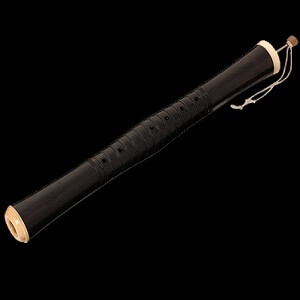Pi
 Pi is a Lanna folk instrument. I don't know the exact history. Lao Bei made from Ruak wood. One end at the perforation hole is a rectangular shape for inserting a tongue made of brass, silver or other metal. To cause a beautiful sound vibration when the player blows or sucks air through the metal tongue.
Pi is a Lanna folk instrument. I don't know the exact history. Lao Bei made from Ruak wood. One end at the perforation hole is a rectangular shape for inserting a tongue made of brass, silver or other metal. To cause a beautiful sound vibration when the player blows or sucks air through the metal tongue.
One side of Lao Bei was drilled by fire-burning iron in order of 7 holes, according to the distance of each sound. By piercing it to penetrate back up to the pipe inserted into the tongue. Therefore, each pi-jum has a long-short size. and small - large, varying according to the desired sound The reason why it is called Pi-jum because it is used as a jum (set) is that it consists of three or more Pis. Can be divided into 5 types according to size:
1. Mae Pi is the largest bagpipe in the same series, about 70-75 cm long, with a low bass sound. When playing in a band, the sound will stand on the ground. and performs the chorus There is a chanting sound like a koi. At present, seung is used to play instead for conciseness and to determine the exact rhythm.
2. Middle bagpipes are medium-sized bagpipes, about 60-65 cm long, with quite bass tones. It acts as a chorus with the pi koi.
3. The pi koi is small, descending from the mother and middle pi, about 40-45 cm long, with a low pitch. and not too sharp Serves to go up or down a song. Every bagpipe must mainly listen to the Pi Koi. Even the chiang seo uses the sound of the koi as the main sound.
4. The pi pi can be classified as a small bagpipe, about 30-35 cm long, with a small pitched sound. There is a gradation of a sound similar to the middle pipe. Doing a chorus with Pi Koi
5. Pi cut or little pinkie It is considered to be the smallest in the Pi Chum band. have a small voice chanting sounds similar to koi At present, it is not popular because it will overlap the way with the koi. Requires players who have the skills to distinguish the way.